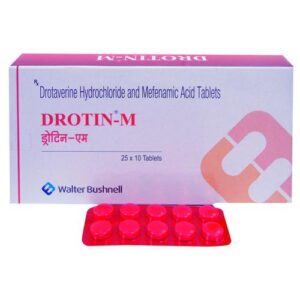MEFENAMIC ACID + DROTAVERINE
Mefenamic Acid: Mefenamic Acid is a nonsteroidal anti-inflammatory drug (NSAID) used to relieve pain, inflammation, and menstrual cramps. It belongs to a class of drugs known as fenamate NSAIDs.
The mechanism of action of Mefenamic Acid involves inhibiting the production of certain chemicals in the body called prostaglandins. Prostaglandins are responsible for causing pain, inflammation, and fever. By inhibiting their production, Mefenamic Acid helps reduce pain and inflammation.
The usual dose of Mefenamic Acid for adults is 500 mg, followed by 250 mg every 6 hours if necessary, not exceeding a maximum daily dose of 1,500 mg. It is usually taken with food to minimize stomach upset. The dose for menstrual cramps is typically 500 mg at the onset of symptoms, followed by 250 mg every 6 hours as needed.
However, it is important to note that dosages may vary depending on the individual’s condition and should be determined by a healthcare professional.
Like any medication, Mefenamic Acid may cause side effects. Some common side effects include stomach pain, nausea, vomiting, diarrhea, dizziness, headache, and rash. These side effects are usually mild and go away on their own. However, if any severe or persistent side effects occur, it is important to seek medical attention.
Mefenamic Acid may also have more serious side effects, such as gastrointestinal bleeding, gastrointestinal ulcers, liver problems, and allergic reactions. It is important to inform a healthcare professional if any unusual or severe side effects occur, as immediate medical attention may be required.
Additionally, Mefenamic Acid should be used with caution in people with a history of stomach or intestinal ulcers, cardiovascular diseases, kidney problems, or asthma.
In summary, Mefenamic Acid is a NSAID used for pain relief, inflammation, and menstrual cramps. Its mechanism of action involves inhibiting prostaglandin production. The usual adult dose is 500 mg, followed by 250 mg every 6 hours if needed. Common side effects include stomach pain, nausea, and headache, but more severe side effects can occur, requiring medical attention.
Drotaverine: Drotaverine, also known as Drotaverine Hydrochloride, is a medication primarily used to treat abdominal pain and cramping caused by various conditions such as irritable bowel syndrome, gallstones, kidney stones, and menstrual pain. It belongs to the class of drugs known as antispasmodics or smooth muscle relaxants.
The exact mechanism of action of Drotaverine is not completely understood, but it is believed to work by inhibiting the enzyme phosphodiesterase type IV (PDE4) and relaxing the smooth muscles in the gastrointestinal tract, uterus, and blood vessels. This leads to the reduction of spasms and improved blood flow in the affected areas, relieving pain and discomfort.
The usual recommended adult dose of Drotaverine is 40-80 mg taken orally three times a day, with or without food. However, the specific dosage and duration of treatment may vary based on the individual’s condition and the doctor’s recommendation. It is important to follow the prescribed dose and duration of treatment.
As with any medication, Drotaverine may cause certain side effects, although not everyone experiences them. Common side effects may include dizziness, headache, dry mouth, nausea, vomiting, blurred vision, and allergic reactions such as skin rash or itching. If any of these side effects persist or worsen, it is important to consult a healthcare professional.
In rare cases, Drotaverine can cause more serious side effects such as hypotension (low blood pressure), increased heart rate, chest pain, difficulty breathing, or severe allergic reactions. If any of these severe side effects occur, immediate medical attention should be sought.
It is important to note that this is a general overview of Drotaverine, and specific information regarding its use, dosage, and side effects should be obtained from a healthcare professional or the medication’s package insert.


